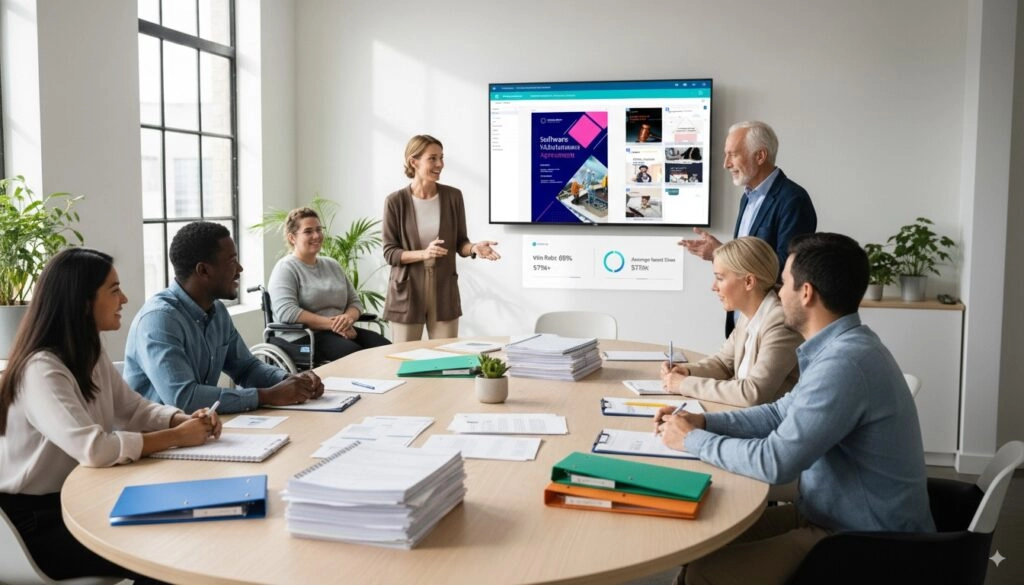The Modern Landscape of Nonprofit Fundraising
The world of nonprofit fundraising continues to shift as organizations face greater competition for supporter attention and philanthropic dollars. With more nonprofits on the scene and donors expecting greater transparency, nonprofits can no longer rely on a single fundraising strategy. Efficiency isn’t just a goal—it’s a necessity.
Today’s successful nonprofit must adapt quickly, diversifying fundraising strategies and harnessing the power of smart, data-driven planning. Nonprofit fundraising strategies that maximize fundraising efforts are far more likely to ensure long-term sustainability and impact. In this environment, effective fundraising goes beyond simply raising money. It’s about building lasting relationships, streamlining processes, and leveraging tools that elevate your entire fundraising approach.
A key player in this evolution is the proposal system. From grant applications to donor appeals, proposal systems now sit at the center of effective nonprofit fundraising—helping organizations strategize, organize, and supercharge their ability to connect with supporters and, ultimately, succeed in their mission.
Understanding Proposal Systems: The Engine of Nonprofit Fundraising
Proposal systems form the organizational backbone of a robust fundraising campaign. At their core, these systems streamline the process of generating, managing, and tracking donor proposals, grant applications, sponsorship packets, and other critical communications. By automating and standardizing proposal generation, nonprofits can ensure every outreach is polished, compelling, and aligned with organizational goals.
With a structured proposal system in place, a nonprofit can:
- Centralize documents and data for easy access by fundraising teams.
- Personalize proposals, tailoring outreach to specific donors or grantors without reinventing the wheel for each request.
- Track statuses and deadlines to never miss out on an important opportunity.
- Collaborate efficiently between departments or team members on complex proposals.
The result? A more professional and timely process, which increases trust with donors and grantmakers, and measurably boosts the chances of securing gifts and grants. Nonprofits that use modern proposal systems see a significant improvement in their ability to maximize fundraising and reduce administrative load.
To learn more about the advantages of transitioning from manual to automated proposals, see The True Cost of Manual Proposal Writing: Why Automation is the Future.
Essential Features of Powerful Fundraising Tools for Nonprofits
Choosing the right fundraising tool can make a remarkable difference in your nonprofit’s ability to engage donors and achieve goals. When selecting an effective fundraising platform, prioritize these must-have features:
- Cloud-Based Access: Allow staff and volunteers to collaborate from anywhere, supporting remote work and cross-team efficiency.
- Automation of Repetitive Tasks: Schedule reminders, automate proposal generation, and set up recurring donor communications to save valuable staff time.
- Donor Management: Centralize donor profiles, track giving histories, and segment supporters for tailored outreach.
- Customizable Fundraising Pages: Design branded, individual fundraising pages or campaigns that reflect your mission and appeal to various donor demographics.
- Integrated Reporting: Generate insightful analytics for everything from campaign effectiveness to donor engagement trends.
- Secure Payment Gateways: Accept multiple forms of donation with peace of mind for both your organization and your donors.
Utilizing a powerful fundraising tool that offers these features means you significantly maximize your fundraising efforts, reduce errors, and present a more professional image. Seamless integration of communication, data tracking, and financial management is essential.
If you’re exploring proposal-building tools designed for efficient nonprofit fundraising strategies, visit this Proposal Builder features page for more details.
Building a Detailed Fundraising Strategy: Planning for Success
Without a clear roadmap, even the most passionate nonprofits can find themselves missing out on fundraising opportunities. That’s why building a detailed fundraising strategy is such a pivotal step in effective nonprofit fundraising.
Every successful nonprofit fundraising campaign starts with planning. Here’s a step-by-step approach to crafting your fundraising plan:
- Set Clear Goals: Define how much you need to raise and why. Be specific and realistic.
- Know Your Audience: Identify key donor segments and tailor your message to resonate with each group.
- Outline Fundraising Activities: Mix and match campaigns—think events, direct appeals, online challenges—to broaden your reach.
- Budget Wisely: Allocate resources to the initiatives with the highest expected return and establish contingency plans.
- Establish Timelines: Map out deadlines for each step in your fundraising journey to stay on track.
This strategic, detail-oriented approach not only keeps your team aligned but also helps you achieve your fundraising goals, increases accountability, and elevates the likelihood of successful fundraising. Regardless of size, every nonprofit organization benefits from a thoughtful fundraising plan.
Diversified Fundraising Methods: Traditional and Digital Approaches
Effectively fundraising for nonprofits demands a toolkit that spans both old and new methods. Relying on just one avenue can limit reach and expose organizations to risk, especially if trends or donor behaviors change. Diversification is the key to success.
- Traditional Fundraising Methods: Think direct mail campaigns, elegant galas, community auctions, and in-person donor meetings. These tried-and-true efforts still drive meaningful engagement and are especially effective for building local support and long-term relationships.
- Digital Fundraising: Leverage popular online fundraising platforms, set up individual fundraising pages for peer-to-peer campaigns, or organize virtual fundraising events accessible from anywhere in the world. Crowdfunding, text-to-give, and social media fundraisers are now essential pieces of modern nonprofit fundraising strategies.
Creative fundraising ideas abound: hybrid events combining live and livestream elements, crowdfunding for urgent causes, or launching an online giving day with matches from sponsors.
Blending a variety of fundraising types not only grows your donor pool but also helps manage risk—if one strategy underperforms, others can compensate. Plus, a multi-channel approach encourages supporters to give in ways that are most convenient for them.
For a deeper look at the importance of integrating strong financial management into all types of fundraising activities, check out this roundup of top invoicing and accounting solutions.
Leveraging Technology: Proposal Software and Automation for Maximized Fundraising
As the nonprofit sector embraces technology, specialized fundraising software becomes a game changer. Automation not only streamlines proposal creation and donor outreach, but also automates reporting, compliance, and follow-up—freeing up staff and volunteers to focus on what matters most: building relationships and delivering impact.
Modern proposal systems empower nonprofits in several ways:
- Simplified Document Creation: Generate professional, tailored proposals with the click of a button—no more copying and pasting or formatting headaches.
- Workflow Automation: Schedule follow-up emails, automate reminders, and maintain clean communication logs for every fundraising campaign.
- Data-Driven Insights: Monitor which proposals succeed, track response times, and adjust tactics as needed to maximize fundraising revenue.
- Compliance and Recordkeeping: Automatically maintain audit-ready records for grant applications and donor communications.
Powerful fundraising tools like Invoice Crowd enable organizations to maximize fundraising efforts, streamline administrative work, and optimize outcomes, all while saving valuable staff resources.
For a comparison of leading proposal software designed to boost online fundraising and automation, explore this guide to proposal solutions.
Best Practices in Fundraising: Writing Winning Proposals
Great fundraising proposals make it easy for donors and grantmakers to say “yes.” But what separates a compelling proposal from the rest? Here are some best practices to help your requests shine:
- Clarity Above All: Clearly articulate your mission, the need, and how donations will make a measurable difference.
- Impactful Storytelling: Use real-life stories and data to connect emotionally while showcasing credibility.
- Alignment with Donor Values: Research your audience—ensure your ask resonates with their philanthropic goals and priorities.
- SMART Objectives: Define Specific, Measurable, Achievable, Relevant, and Time-bound goals for your project or program.
- Professional Presentation: Use consistent branding, polished formatting, and concise language.
Carefully crafted proposals instill trust, highlight your professionalism, and improve your chances with both grant makers and major donors. Strong proposal writing tactics remain at the heart of effective nonprofit fundraising.
Looking for more actionable guidance? See the Top 10 Tips for Creating Effective Proposals for insight into refining your grantwriting and donor appeals.
Digital Engagement: Email Fundraising Strategies and Social Media Fundraising
Digital fundraising opens up boundless opportunities for nonprofits to connect with supporters—anytime, anywhere. But simply launching an email or social media campaign isn’t enough. True engagement requires strategic communication built on segmentation and storytelling.
- Email Fundraising Strategies: Segment your email lists so supporters receive relevant content tailored to their interests. Well-crafted subject lines, personalized messaging, and clear calls-to-action boost open rates and drive more donations.
- Social Media Fundraising: Leverage platforms like Facebook, Instagram, Twitter, or LinkedIn to share powerful stories, celebrate milestones, and activate peer-to-peer fundraising. Encourage volunteers and donors to create their own mini-campaigns and amplify your message.
- Peer-to-Peer Fundraising: Empower your biggest advocates to fundraise on your behalf—expanding your reach far beyond your core audience.
Timing is everything with digital communication. Schedule updates around campaign milestones, and utilize real-time tools like live video or stories to encourage participation.
Effective digital fundraising goes beyond dollars—it builds community, keeps supporters engaged, and increases future engagement. For more thoughts on harnessing digital channels, have a look at this discussion of social media’s impact.
Running Engaging Fundraising Campaigns & Events
An engaging fundraising event or campaign can galvanize your community and ignite excitement for your cause. But it isn’t just about the event itself—success comes from careful planning and thoughtful follow-up.
- Conceptualization: Decide on a unique theme or concept that resonates with your supporters and fits your mission.
- Promotion: Build anticipation with multi-channel marketing—emails, social posts, local news, and partner networks.
- Partnership Building: Collaborate with local businesses, sponsors, or other organizations to increase reach and resources.
- Seamless Registration & Donation: Make it easy for supporters to join your fundraiser and give, whether online or at a physical event.
- Follow-Up: Express appreciation, report outcomes, and share the difference their support has made—building loyalty and encouraging future participation.
Think outside the box: virtual 5ks, hybrid galas, online auctions, giving day challenges, or themed trivia nights—all can be run cost-effectively with the help of a powerful fundraising tool. By keeping events dynamic and donor-focused, nonprofits can inspire greater support and generate stronger results.
Tracking Performance: Reports, Analytics, and Improving Fundraising Outcomes
A fundraising plan is only as effective as your ability to measure its outcomes. That’s why tracking and analytics should be built into every nonprofit’s workflow, informing each new strategy and campaign.
- Set Key Performance Indicators (KPIs): Track metrics like donor retention, average gift size, and campaign ROI.
- Insightful Reporting: Use fundraising tools to generate accessible reports—revealing what’s working, and where shifts are needed.
- Continuous Improvement: Make data-driven decisions to refine your outreach, communication, and engagement efforts for future fundraising success.
With robust analytics and regular reporting, organizations spot trends early, celebrate achievements, and quickly adapt to maximize their fundraising efforts.
For details on reporting and analytics features that help increase fundraising outcomes, visit the Generate Reports page.
How Proposal Systems Enable Effective Fundraising for Nonprofits
Consider a nonprofit seeking to grow its impact by launching a new afterschool program. The team faces the challenge of securing funding from various sources, including grants, corporate sponsors, and individual donors.
By implementing a proposal system, the nonprofit can:
- Quickly assemble professional grant applications tailored to each funder’s requirements.
- Centralize donor communication, enabling timely follow-ups and automated acknowledgments.
- Collaborate across departments to keep messaging consistent and deadlines tightly managed.
These capabilities free staff from manual processes, allowing more attention to mission-driven work. Furthermore, integration with a platform like Invoice Crowd ensures seamless donation tracking and comprehensive reporting, supporting stronger donor relationships and greater fundraising revenue.
To discover how purpose-built software can streamline donation management and proposal workflows, explore this resource on invoicing software for nonprofits.
Conclusion: Elevate Your Fundraising—The Future of Nonprofit Proposal Systems
Harnessing the power of effective proposal systems transforms what’s possible for nonprofit fundraising strategies. By embracing best practices, adopting innovative fundraising tools, and applying new fundraising strategies, organizations stand poised to not only maximize their fundraising efforts but also deepen their mission impact.
Investing in powerful fundraising tools allows teams to work more efficiently, engage donors in meaningful ways, and achieve ambitious goals. As the landscape continues to evolve, nonprofits equipped with the right technology and tactics will lead the charge in future fundraising.
Ready to take your nonprofit’s fundraising to the next level? Explore how modern proposal systems like those offered by Invoice Crowd can help maximize your fundraising efforts, simplify your workflow, and empower your organization to reach—and exceed—your goals.
“`


